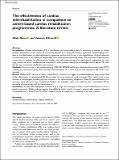Files in this item
The effectiveness of cardiac telerehabilitation in comparison to centre-based cardiac rehabilitation programmes : a literature review
Item metadata
| dc.contributor.author | Owen, Olivia | |
| dc.contributor.author | O'Carroll, Veronica | |
| dc.date.accessioned | 2022-04-07T15:34:57Z | |
| dc.date.available | 2022-04-07T15:34:57Z | |
| dc.date.issued | 2022-04-04 | |
| dc.identifier | 277892180 | |
| dc.identifier | e324ff40-783a-495e-9a64-dd5691771507 | |
| dc.identifier | 000777914300001 | |
| dc.identifier | 85129153609 | |
| dc.identifier.citation | Owen , O & O'Carroll , V 2022 , ' The effectiveness of cardiac telerehabilitation in comparison to centre-based cardiac rehabilitation programmes : a literature review ' , Journal of Telemedicine and Telecare , vol. OnlineFirst . https://doi.org/10.1177/1357633X221085865 | en |
| dc.identifier.issn | 1357-633X | |
| dc.identifier.other | ORCID: /0000-0001-5777-104X/work/111210029 | |
| dc.identifier.uri | https://hdl.handle.net/10023/25157 | |
| dc.description.abstract | Introduction: Cardiac rehabilitation (CR) is an effective, yet under-utilised, form of secondary prevention in cardiac patients. Telemedicine is one method of overcoming barriers to accessing CR. Previous systematic reviews highlight variation in the effectiveness of telerehabilitation programmes and current literature lacks identification of which telemedicine interventions are most effective, despite differences in the results of primary studies. The objectives of this literature review were to: evaluate the effectiveness of cardiac telerehabilitation compared to centre-based programmes for managing cardiac risk factors, satisfaction and adherence in cardiac patients; identify the technologies used to deliver CR; identify the key components of effective interventions. Methods: A literature search was conducted using MEDLINE, EMBASE and Scopus. Randomised controlled trials (RCTs) involving an intervention group that received telerehabilitation and a control group that attended a CR centre were included. Results: Twelve RCTs met the inclusion criteria. There is evidence to suggest that telerehabilitation programmes have similar effectiveness to centre-based CR. Phones were the most commonly used technology. Most studies used a combination of technologies including personal computers and self-monitoring equipment. Phase III telerehabilitation programmes using self-monitoring, motivational feedback and education were more effective than centre-based CR for increasing physical activity and functional capacity. Conclusion: Cardiac telerehabilitation is delivered by a range of technologies and has a similar effectiveness to centre-based programmes. While evidence suggests that additional health benefits are seen in patients who receive a telemedicine intervention in Phase III of CR, further evidence would be required to confidently draw this conclusion. | |
| dc.format.extent | 16 | |
| dc.format.extent | 1154807 | |
| dc.language.iso | eng | |
| dc.relation.ispartof | Journal of Telemedicine and Telecare | en |
| dc.subject | Telerehabilitation | en |
| dc.subject | Telemedicine | en |
| dc.subject | ehealth | en |
| dc.subject | Telehealth | en |
| dc.subject | RA0421 Public health. Hygiene. Preventive Medicine | en |
| dc.subject | RC Internal medicine | en |
| dc.subject | 3rd-DAS | en |
| dc.subject | SDG 3 - Good Health and Well-being | en |
| dc.subject.lcc | RA0421 | en |
| dc.subject.lcc | RC | en |
| dc.title | The effectiveness of cardiac telerehabilitation in comparison to centre-based cardiac rehabilitation programmes : a literature review | en |
| dc.type | Journal article | en |
| dc.contributor.institution | University of St Andrews. School of Medicine | en |
| dc.contributor.institution | University of St Andrews. Education Division | en |
| dc.contributor.institution | University of St Andrews. Population and Behavioural Science Division | en |
| dc.identifier.doi | https://doi.org/10.1177/1357633X221085865 | |
| dc.description.status | Peer reviewed | en |
This item appears in the following Collection(s)
Items in the St Andrews Research Repository are protected by copyright, with all rights reserved, unless otherwise indicated.

